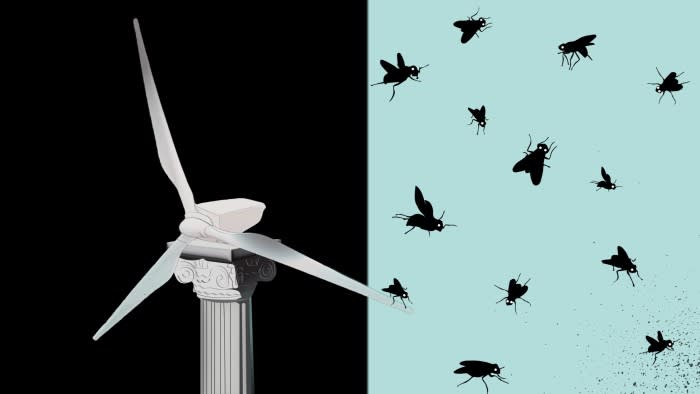Unlock the US Election Countdown newsletter for free
The stories that matter on money and politics in the race for the White House
Sometimes politicians get wise. More often they get accidentally smart — or lucky. And this week, as America marks the second anniversary of the Inflation Reduction Act, that second point looks newly relevant.
The reason is that when US President Joe Biden unexpectedly unveiled the IRA on August 16 2022, it primarily seemed a crowd-pleaser for Democrats: the bill aims to slash carbon emissions by offering about $400bn subsidies for renewable energy technologies, such as solar power and electric vehicles.
No, this does not have much to do with inflation (except if it cuts renewable energy prices); indeed, an advertising watchdog would probably deem the IRA name to be downright misleading.
However, the bill does mark the most dramatic single policy move seen to date in the west to accelerate a green transition. And, unsurprisingly, this has made it a convenient political punch bag for the team around Donald Trump, the Republican presidential contender, who have repeatedly vowed to repeal it.
Hence why it pays to be accidentally smart. This week John Podesta, White House adviser, revealed that one irony of the IRA is that almost 60 per cent of the jobs it has created have gone to districts where Republican representatives voted against its passage through Congress. And FT analysis suggests that some 80 per cent of the investments from the IRA and the separate Chips Act (to boost chip manufacturing) have occurred in red not blue states.
Why? Heather Boushey, a White House economic adviser, tells me this reflects wise economic planning: the bill is designed to encourage activity in deprived areas, such as the Republican-leaning rustbelt zones. Other observers blame it on a happy accident: because construction, planning and employment laws are much looser in red states, it is much easier to start new investments there.
Either way, this skew means that the residents of red districts in states such as South Carolina, Oklahoma and Texas now have a vested interest in protecting Biden’s policy baby. After all, manufacturing investment linked to the IRA has already created 300,000 jobs, according to Podesta — and added 0.35 percentage points to gross domestic product, according to Boushey. This is easily the biggest investment boom since 1981.
And many Wall Street financiers also have an incentive to support it too — even if they vote Republican — because private capital groups have investment funds piggybacking off these subsidies.
So will this guarantee that IRA reaches its third birthday, even if Trump wins? And can it truly decarbonise America? The answers are respectively “probably yes” and “probably no”.
Policymakers close to Trump tell me they really will repeal the bill, if they win, in the name of cutting the fiscal deficit. And this is already spooking investors: a FT investigation shows that 40 per cent of announced IRA and Chips Act projects have been delayed, partly because of policy uncertainty.
However, I personally doubt whether Trump will be able to overturn these Republican vested interests. Indeed, 18 House Republicans have already written to Speaker Mike Johnson arguing against any repeal, since this “would create a worst-case scenario where we would have spent billions of taxpayer dollars and received next to nothing in return”.
Moreover, Pew Research reports that 78 per cent and 72 per cent of voters want more solar and wind power (albeit down from 90 and 83 per cent in 2020) — and nearly two-thirds want America to be carbon neutral by 2050. Separately a Morning Consult/Allstate poll shows that 73 per cent of Americans want more proactive government action to promote climate resilience, and 53 per cent would pay more taxes to fund that. This ratio is likely to rise, given that the cost of weather disasters is surging.
However, the sobering point that investors also need to recognise is that even if these forces keep the IRA in place, this will not be enough to truly decarbonise America. One reason is that oil and gas production continues to surge: a little-noticed detail of Biden’s presidency, as Adam Tooze, a Columbia University professor, notes, is that the White House handed out 758 drilling licenses last year, twice the rate seen under Trump. This is yet another bitter irony.
Moreover, even accounting for the IRA, the world has only installed about a tenth of the low emissions infrastructure needed to achieve carbon neutrality by 2050, according to a new McKinsey study. That partly reflects a lack of joined-up, holistic planning. It also arises because green tech has now become a focus for geostrategic rivalry between the US and China, rather than a trigger for collaboration, as many people (like me) once hoped.
Then there is a third, more subtle, cultural problem: because innovations such as ChatGPT are spreading at lightning speed, voters and politicians generally do not appreciate the degree to which a green transition requires a long and messy investment in physical infrastructure. The key point about the IRA is that it is a first step on a journey — not a magic wand.
And that, of course, is exactly why we need to pray that it remains in place, whatever happens in November. As pieces of legislation go, the IRA is certainly not perfect. But not having it would be worse. So all eyes should now be focused on those 18 Republicans who wrote to Johnson last week. They may yet come to look like accidental — self-interested — heroes.
gillian.tett@ft.com


